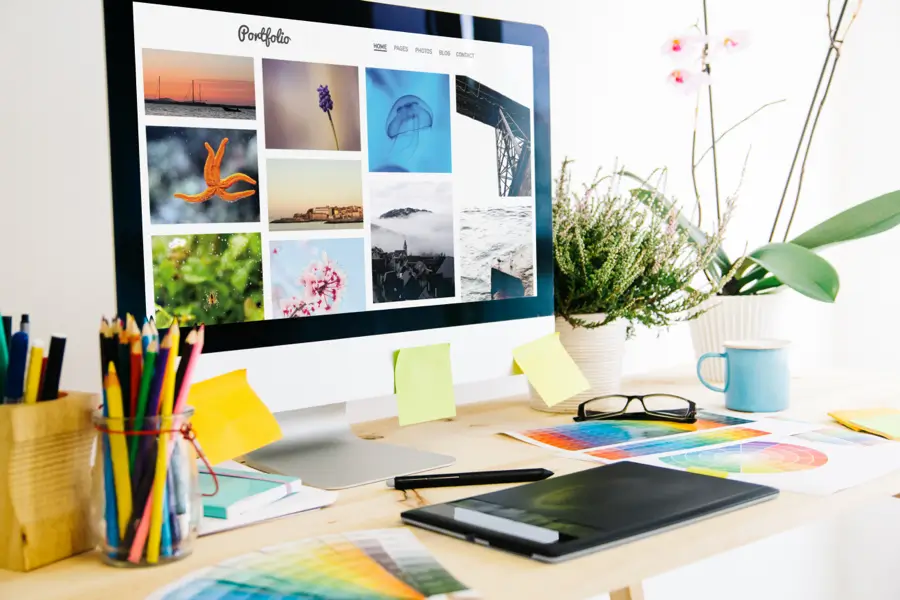
PROFESSIONAL DEVELOPMENT

As a graphic designer, the first and most obvious question you may ask is, “why do I need a portfolio”. After all, I have the skills and training to meet the job’s requirements. I have the dedication and artistic talent. I also have a great resume highlighting my accomplishments. Why is a portfolio so important?
In a sea of applicants, your portfolio showcases who you are as a designer. It presents your unique style and knowledge of design techniques to potential clients. A portfolio is also one of the first and most important things an employer will review when considering you for a job. And, because clients are always looking for the best combination of talent and value, graphic artists must put their best foot forward, and show them what they can do.
To demonstrate your artistic talent and knowledge of graphic design, you will want to showcase four main areas of your personality and ability:
Wikipedia defines a portfolio as, “an organized presentation of an individual’s education, work samples, and skills.” But, as technology continues to evolve, many designers find themselves struggling between creating a digital portfolio or a print portfolio. The question often arises, “are traditional methods best, or does modern technology have the upper hand?”
Print portfolios are considered one-off pieces, which are typically tailored to a specific job. They are immersive, and when done well can be very impressive. On the other hand, digital portfolios existonline and are often more templated, allowing you to easily and instantly share and distribute your portfolio via mobile device, email, digital download, or use it to acquire clients directly online. In reality, you will probably need both print and digital versions of your portfolio as each has unique benefits to take advantage of.
The more you know and the more you understand about the needs and background of your audience, the better you can prepare your portfolio. For example, if a potential employer is looking for a designer to work exclusively on website design, then putting together a professional personal website that highlights both your design talent, as well as your ability to build a great looking site is probably best. But, if a client wants to hire you strictly for print work, then a print portfolio might be better. Research what the client or employer is looking for, what type of work and style is needed, and who else works for the client or company. Cater your portfolio to your client or employer.
In a 2013 study completed by the digital education company, Hyper Island, 78 percent of respondents chose ‘personality’ as the quality they most desired in new employees. Although skills cannot be overlooked, personality wins across the board. Considering that fact, ask yourself who you are as a designer, and where do you want to go? What are your career goals and what does your portfolio say about you as a person and as a designer? Maybe this is a good place to include some personal projects in addition to your professional work samples. For example, if you volunteer your design services to your favorite charity, include that too in your portfolio. Doing so will give employers a better idea of your interests and reveal aspects of your personality not apparent in your portfolio.
And, although personality is of vital importance, a note of caution. Keep in mind you are selling your skills as well as your personality, it is important that your personality doesn’t overshadow the needs of the client or your talents and technique as both should work together.
Most clients and employers are looking for designers who can solve problems and come up with unique ideas and concepts, rather than just designing what they are told to design. Although a client may think they know exactly what they want for a project, you as the designer may have a better idea about how to tell the client’s story or get the client’s point across to his or her audience. So, instead of simply designing what you are told to design, think outside the box and use your creativity to come up with alternative ideas and concepts.
Your portfolio shows clients and employers what you are capable of. It is a showcase of your blood, sweat, tears, talents, and triumphs. And, as a good book tells a story, so should your portfolio.
Begin with your role in a project. Were you the team lead or a junior designer? What process did you use to arrive at the design from concept to final proof? It doesn’t hurt to include metrics of your successes either if you have them. Letters or testimonies from happy clients should also be included. As you gain experience, you will find that referrals from past clients can be a very persuasive means of obtaining new clients.
Most clients want a graphic designer who can do more than one thing. Today, they might need a print brochure, but tomorrow they want a new website design. If they like your work on the brochure, they will also want you to work on their new site. Include samples in your portfolio that address what the client is looking for, but also include a variety of other digital and print work that shows what else you can do for them. Companies also look for versatility and willingness to learn and grow. But, be careful. The quality of your work is far more important than the quantity – show only your best work.
Along with what to include in your portfolio, there are also several things not to include. For example, don’t use language that is overly formal or technical when explaining your work, but also be careful not to sound too casual. Pick a tone in-between to make for the most comfortable read. This makes you more approachable and less standoffish. And, don’t forget to pay attention to even the smallest details. Customize your portfolio for the job you are applying for, or the client you are presenting to. Don’t leave anything out. It can be tempting to only include bright and bold images in your portfolio, but making the effort to explain the design process behind your project is just as important. Just don’t go on and on; keep it short and sweet. If the client wants more explanation, they’ll ask for it.
As mentioned, in today’s ever-changing digital world, digital portfolios are becoming more and more essential. They are your storefront, and anyone, located anywhere, and at any time of the day can see your body of work. Share the link to your online website/portfolio with perspective clients or include a QR code on your business card to hand out at networking events. But, before you invest in a personal/business website, consider the pros and cons.
Your own website can be completely customizable and will allow you to add-to as you grow as a designer. But, a personal website can be expensive and take a lot of time to construct and design.
As an alternative, you might consider joining an online community to showcase your work, such as Behance, Dribbble, Zerply, deviantART, carbonmade, Forrst, and many more. Online communities have the potential to drive traffic to your portfolio, and most have low up-front costs. But an online community site is not as customizable for each client. In the end, because there are so many platforms to choose from, it’s worth the time to investigate the features and benefits to make sure it meets all your needs.
Whether digital or print, it is imperative to update your portfolio frequently. After all, you are constantly evolving as a designer so you should showcase that growth in your portfolio. Unlike a print portfolio, the digital world has no page limitations, so including samples that appeal to a variety of audiences is a good idea because you never know who will view your portfolio. That said, it is still wise to be selective. Displaying everything may dilute the message you are trying to communicate. In addition, if you are sharing your portfolio with a specific company or potential client, create a link just for them. This not only shows your dedication and interest but also your most relevant work.
Print portfolios can be a lot of work and take a great deal of time to put together, but they are invaluable if going to a physical, face-to-face interview. While you might have used a generic template to assemble your print portfolio, prior to the interview, take a good look at your body of work and adjust it for the specific client, project, or job.
You can also think of your print portfolio as a personal cover letter that shows why you are the perfect fit for a specific job or contract. And, because your portfolio is so personal, you’ll want your creativity and individuality to stand out in this competitive field.
If you really want to be remembered, leave behind something that the company or client can use in the future, like a DVD or flash drive. This will ensure that your portfolio doesn’t get tossed in the trash, because even if you don’t get this job, the client might remember you the next time a contract or position becomes available.
If you still need ideas on how to set yourself and your portfolio apart from the competition, look at other designer’s portfolios and pick out what you like and what you dislike about each of them. This can be a great starting point for launching your own portfolio. But, remember, don’t copy their ideas. Instead, showcase yourself as the unique and talented designer you are. When you brand yourself effectively, you give prospective employers and clients an idea of the level of your professionalism, as well as the confidence they need to hire you.

The Art Career Project is a trusted resource for emerging and professional artists.